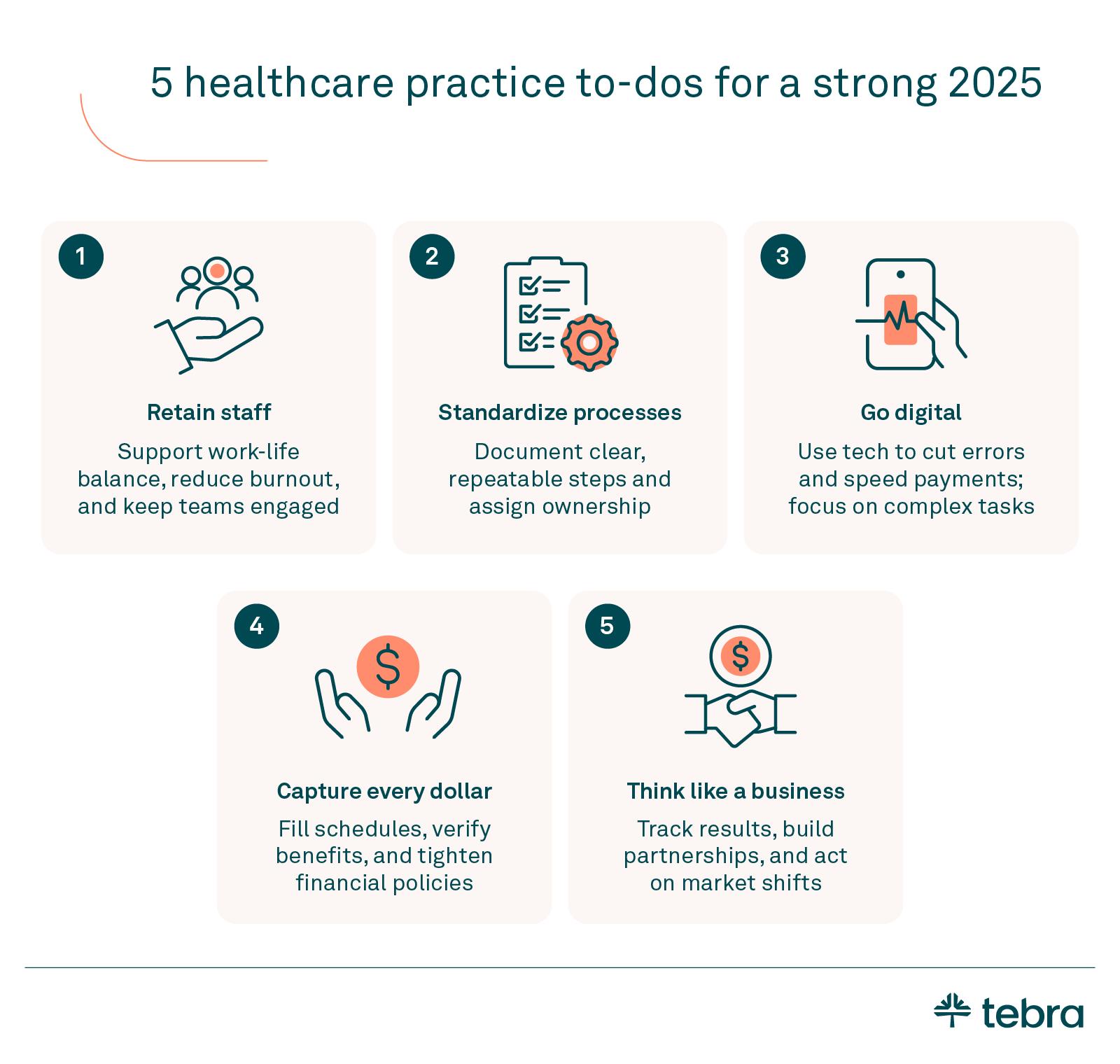
- With payers scrutinizing claims more closely, avoid errors and rework upfront to protect your revenue cycle and shorten reimbursement delays.
- Consistently verify and confirm patient details, using automation to precheck eligibility and claims data, reduce manual steps, and support cleaner workflows.
- Make sure you have the right team and processes that streamline work, cut repetitive tasks, and improve morale to lift patient experience and reduce turnover.
Healthcare costs remained elevated this year, making it a major healthcare industry challenge in 2025. Collections remain challenging for medical practices and billing companies as well. In the United States healthcare system, rising costs and workforce shortages continue to squeeze margins and slow reimbursement for healthcare providers across healthcare services. These pressures are top of mind for healthcare leaders and other stakeholders.
In our recent webinar, healthcare business consultant Aimee Heckman shared strategies from her 35+ years of experience with Tebra's Director of Customer & Partner Marketing, Amanda Zeosky. They walked through the biggest barriers to getting paid and offered practical steps for 2025.
Watch the full on-demand webinar, or read the highlights below.
State of the healthcare industry
These key industry challenges affect how practices and billing companies do business and get paid. Since the pandemic, the healthcare system and wider healthcare industry have faced persistent shortages, recurring supply chain disruptions, and an aging population that raises demand and complexity.
Across the healthcare sector, organizations are moving toward value-based care, which depends on stronger partnerships among payers, hospitals, and private practices. At the same time, rapid advancements in data, analytics, and virtual tools are reshaping operations and reimbursement. Together, these forces create the context for 2025 planning and day-to-day execution.
HIPAA data breaches and cybersecurity

Reports show meaningful improvement even as risk remains. In July 2025, US incidents fell month over month, and fewer individuals had their health information exposed. Still, the Change Healthcare cyberattack demonstrated how one event can ripple across healthcare organizations, disrupt claims, and strain clinicians and patients.
To reduce exposure and protect patient safety while improving operational efficiency, focus on the basics and add modern controls:
- Train regularly: Educate all staff on phishing and cybersecurity best practices.
- Harden access: Require multi-factor authentication and least-privilege roles.
- Monitor in real time: Use real-time alerts and logs to detect cyberattacks quickly.
- Practice response: Build incident response workflows and run tabletop exercises.
- Document and review: Keep policies current and audit sharing and usage of health information.
- Secure interoperability: Vet vendors, verify interoperability safeguards, and maintain BAAs.
These steps will not eliminate ransomware or data loss, yet they help practices identify threats sooner and recover faster.
HIPAA Right of Access
The HIPAA Right of Access requires providers to release records within 30 calendar days. Some states require 15 days. The Office for Civil Rights (OCR), a division of the U.S. Department of Health and Human Services, has continued active enforcement in 2025. In March, the agency imposed a $200,000 civil money penalty against Oregon Health & Science University for failing to provide timely access to records.
Clear workflows help teams locate and deliver requested health information quickly. Faster access improves patient experience and supports quality care during care transitions. Review request intake, identity verification, and fulfillment steps.
Train staff. Track deadlines. Document any exceptions. Use patient portals to accept requests and keep audit logs of receipt, status, and completion. These initiatives reduce risk while making compliance repeatable.
Medicare's 2025 final fee schedule
Medicare finalized several updates that affect reimbursement in 2025. Per the 2025 Physician Fee Schedule final rule, the Centers for Medicare & Medicaid Services (CMS) confirmed a conversion factor decrease of about 2.83% to $32.35. For primary care, CMS expanded G2211 and introduced advanced primary care management services.

These updates may help practices account for visit complexity and ongoing care coordination. New caregiver training codes also recognize time spent supporting families. These changes touch everyday work for clinicians and shape downstream revenue cycle planning, pricing, and documentation inside electronic health records.
Some flexibilities continue in telehealth in 2025, though several pandemic-era policies phased down on October 1, 2025.. Practices should review Medicare telehealth policies and place-of-service rules before billing. Together, these updates influence visit scheduling, coding choices, and financial forecasts tied to value-based care.
| The good news | The bad news |
| G2211 complexity add-on code expanded | Decrease of 2.83% in the conversion factor for 2025 from $33.2875 in 2024 to $32.3465. |
| New caregiver training services codes added (G0539-G0543) | Sequestration of 2% remains in place |
| Advanced primary care management (APCM) services (G0556-G0558) | Restoration of pre-COVID geographic and originating restrictions for telehealth |
Payer challenges
Payer policies tightened in 2025. Getting paid on the first submission is harder and slower, which strains teams and budgets. These patterns drive denials and rework:
- Requests for documentation: Additional records and chart notes before adjudication.
- Continuity of Care Program denials: Coverage disputes during transitions and referrals.
- Coordination of benefits errors: Primary vs. secondary mismatches at check-in.
- Stricter ICD-10 specificity: More edits for vague or unsupported codes.
- Prior authorization holds: Delays that push visits out and extend wait times.
The result is more touches per claim, higher healthcare costs, and pressure on staffing that reduces operational efficiency. Track your top five reasons for denial by payer, CPT, and location.
Assign an owner. Set weekly targets for first-pass rate and days to payment. Use these findings to prioritize fixes at intake and posting. The next sections outline practical steps to reduce denials and move payments faster with your front desk and coding teams.
Overcoming payer roadblocks
Claim denials drain time and cash. Small adjustments help. Use automation and better workflows to optimize eligibility checks, documentation handoffs, and follow-ups. Faster action on clean data keeps care delivery moving. Bills are more accurate on the first pass. Rework falls.
Patient outcomes improve because visits happen without delays or surprise bills. Set simple targets and measure them weekly. Share results in huddles so teams see progress.
Improve your front desk processes
A practice's front desk sets the pace for payment. Tight, repeatable steps prevent errors before they reach payers:
- Always check eligibility and coordination of benefits with real-time tools. Confirm plan details, deductibles, and copays.
- Verify PCP attribution often to avoid denials. Update records and referrals while the patient is present.
- Double-check every field at check-in. Match IDs, addresses, and coverage exactly.
Patient kiosks that sync with electronic health records reduce manual entry and typos. The result is fewer reworked claims, a smoother patient experience, and more high-quality data for healthcare providers at the point of care.
Payer-proof your coding
To reduce denials and support smooth audits, tighten documentation and coding at the source by following these best practices:
- Clearly capture the chief complaint, history, exam, and medical decision-making.
- Avoid generic templates that copy forward irrelevant details.
- Describe abnormal findings with specifics.
- Choose the most accurate diagnosis codes and use modifiers only when criteria are met.
- Keep notes legible and complete so reviewers see the clinical story without guessing.
- Support clinicians during audits and handoffs with thorough documentation.
- Improve interoperability by using structured fields and clear notes that transfer cleanly between systems.
That consistency helps teams deliver quality care and protects patient outcomes across referrals and settings. Audit a small sample each month, close gaps with quick coaching, and update tip sheets as payer rules change.
5 to-dos for a strong 2025
Here are 5 items for your 2025 to-do list.

1. Retain your best staff
Everyone is working overtime to keep valuable team members and avoid turnover costs. Support work-life balance. Check in often. Ask if roles fit skills. Keep people engaged and invested in the practice's success. Watch for burnout and promote wellness across the healthcare workforce.
2. Standardize policies and procedures
Clear, consistent steps present a united front to patients and clients. Walk through processes with staff. Document improvements. Tie updates to specific initiatives and make owners visible to key stakeholders so follow-through happens.
3. Maximize digital processes
Use technology to reduce routine work and speed payments. Digital intake forms cut errors and start collections before visits. RPA helps billing teams focus on complex tasks. Layer in artificial intelligence, generative AI, and machine learning, where they add real value.
4. Capture every dollar
Avoid leaving money on the table. Fill the schedule. Verify benefits at every point of service. Use clear policies on estimates and refunds. Track cost savings and review pricing so adjustments are deliberate.
5. Think like a business
Measure results and adjust quickly. Build partnerships that expand referral volume or services. Monitor market moves and consider selective mergers that strengthen capabilities and reduce overlap.
Your 2025 housekeeping tasks
Quick tune-ups keep payments moving and problems small. Use this checklist to stay current and confident.
- Run a HIPAA security risk assessment: Update policies, refresh staff training, enforce MFA, and document fixes across your cybersecurity program.
- Test incident response: Run a ransomware tabletop and a timed restore from backups. Verify phone trees, vendor contacts, and escalation paths.
- Monitor in real time: Confirm alerting on endpoints and firewalls. Review EHR audit logs and renew BAAs with third parties that touch health information.
- Review payer updates: Track monthly bulletins for Medicare and Medicaid. Note rate changes, prior authorization rules, and place-of-service requirements.
- Update code sets and fee schedules: Load current CPT, HCPCS, and ICD files. Align charge master pricing with coverage and contract terms.
- Tighten front-desk eligibility: Use real-time checks to coordinate benefits and PCP attribution. Correct errors while the patient is present.
- Tune claim scrubbers and edits: Fix recurring denial patterns. Watch clean claim rate and first-pass payment as core revenue cycle metrics.
- Refresh financial policy: Standardize estimates, deposits, refunds, and hardship options. Keep scripts simple and consistent.
- Measure what matters: Track days in A/R, denial overturn rate, and time to payment. Pilot small interventions and keep what works.
Bring it all together
When teams verify data at intake, standardize processes, and use automation, claims move faster, and fewer errors reach payers. That helps providers deliver high-quality care while improving patient outcomes and strengthening operational efficiency.
Aimee Heckman's guidance focuses on what works today: clean documentation, precise coding, and simple front desk routines that keep the revenue cycle moving. Use her tips and track wins.

Get all the details
Want to hear all the nitty-gritty, plus practical examples? Check out the full on-demand webinar.
If you are ready to align scheduling, eligibility, billing, and patient payments in one place, explore Tebra for practical workflows that support cleaner claims and better conversations at check-in.
Answers to common questions about getting paid in 2025
You might also be interested in
Crack the code for beating medical billing challenges with this free workbook — which provides tips around improving patient collections, streamlining claims submissions, and reducing rejections and denials.
- Current Version – Oct 28, 2025Written by: Jean LeeChanges: This article was updated to include the most relevant and up-to-date information available.









